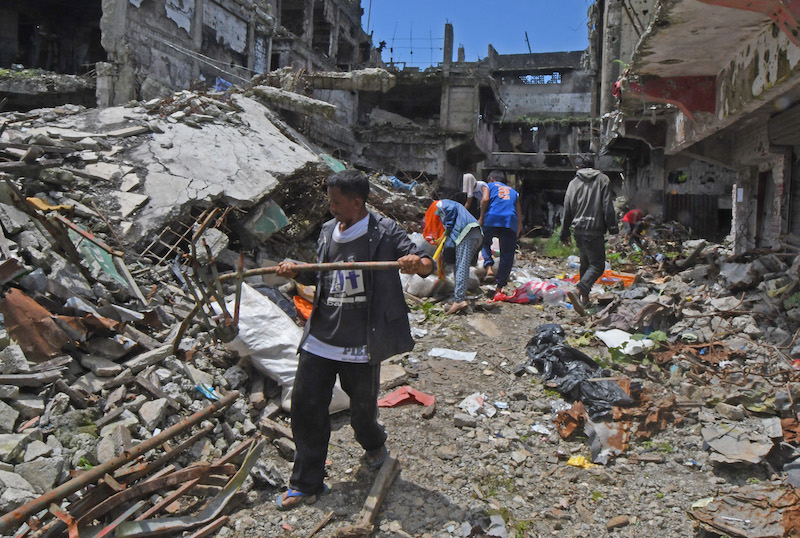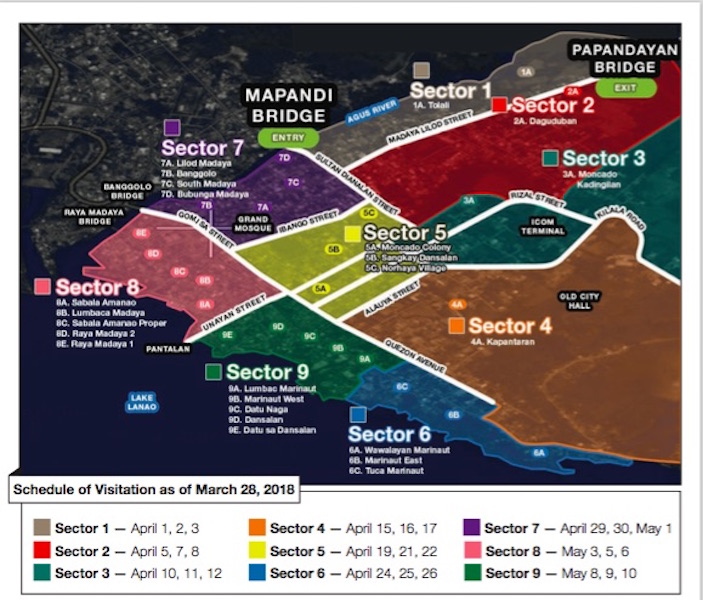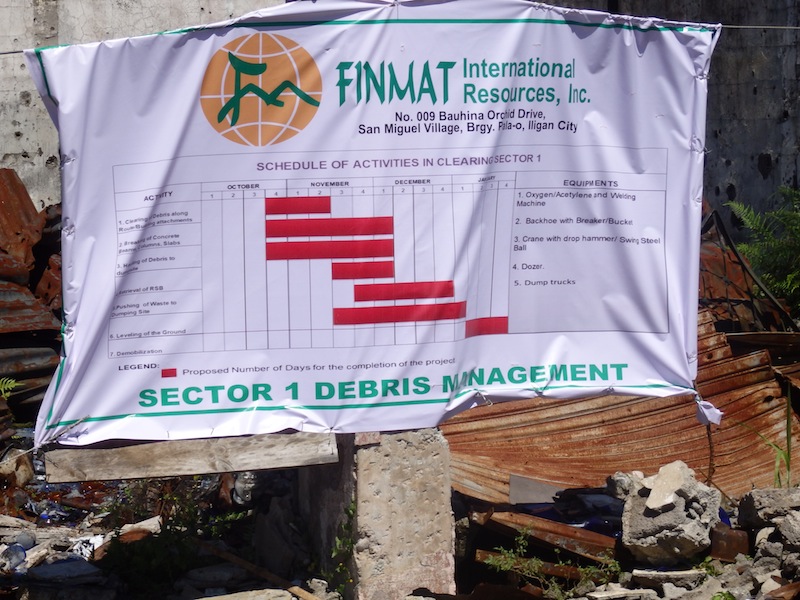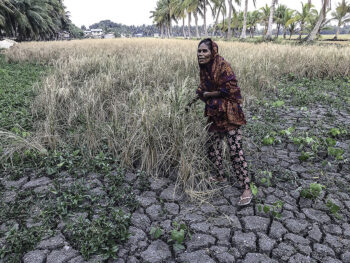MARAWI CITY (MindaNews / 02 November) – Residents in the 24 barangays across the 250-hectare Ground Zero, the battleground between government forces and the Islamic State-inspired Maute Group and its allies last year, will be able to return home “middle of 2020,” the Task Force Bangon Marawi (TFBM) said.
TFBM chair and Housing Secretary Eduardo del Rosario announced at the groundbreaking rites at the Rizal Park last Tuesday that displaced residents from Ground Zero, now referred to as Most Affected Area (MAA) will be able to return to rebuild their homes by “middle of 2020.”
Del Rosario led the groundbreaking in lieu of President Rodrigo Duterte.
 Residents scavenge for whatever has value from the ruins of their homes and buildings during the Kambisita sa MAA (Visit the Most Affected Area) on May 9, 2018. Kambisita allowed residents of Ground Zero to visit their villages at three days per sector, from 6 a.m. to 3 p.m. on April 1 to May 10. MindaNews photo by FROILAN GALLARDO
Residents scavenge for whatever has value from the ruins of their homes and buildings during the Kambisita sa MAA (Visit the Most Affected Area) on May 9, 2018. Kambisita allowed residents of Ground Zero to visit their villages at three days per sector, from 6 a.m. to 3 p.m. on April 1 to May 10. MindaNews photo by FROILAN GALLARDO
Developers, he said, need 18 months for the debris management and road network widening and provision of basic utilities, after which “you will be allowed to construct your houses provided kukuha kayo ng building permit sa city.”
Eighteen months from October 2018 is April 2020.
Del Rosario said building permits must be secured from the city government so these are recorded and taxed. No construction will be allowed if these are not registered, he said.
He was apparently referring to the problem in pre-siege Marawi, where a number of buildings were constructed without permit.
“Rapid development”
Housing Undersecretary Falconi Millar, head of the TFBM Secretariat, started his presentation on the MAA Project Brief by saying that October 30, 2018 was a “very historic day” in that it “will mark the start of the rapid development inside the Most Affected Area.”
“The reconstruction of Marawi City as promised by President Rodrigo Roa Duterte starts today,” he said, adding that groundbreaking is “merely ceremonial” but in their hearts, it “would be a very, very meaningful day” because “puspusan na po ang susunod na makikita ninyong mga gawain dito sa Most Affected Area” (you will see rapid development here in the MAA).
Duterte declared Marawi “liberated from the terrorist influence that marks the beginning of rehabilitation for the people” on October 17, 2017.
It took one year and 13 days before the Duterte administration could break ground to signal the start of the MAA rehabilitation.
Del Rosario asked for “understanding for what happened” and “patience and cooperation for the whole duration of the rehabilitation” which he assured would be completed by end of 2021.
He said reconstructing “a much better, prosperous Marawi City” was estimated to take five to seven years but “we will do it in three years and that is only possible if magkaisa tayo” (we unite).
“New Marawi”
Tarpaulins bearing the message “Marawi will rise again!” were displayed prominently onstage, near the site of the laying of the time capsule and in strategic areas in the MAA.
Among the features of the “New Marawi” that would rise by yearend of 2021, Millar, said are a museum, memorial park, fire station, police station, Grand Padian (market) , a convention center that can seat around 1,500, a parking building, elementary and high schools, school of living tradition, hospital, inter-modal transport terminal, seaport, and a lakeside promenade.
He also mentioned the construction of 24 barangay halls for each of the villages of Ground Zero.
He said there would be a sewage treatment plant in and out of the MAA, and underground cables for public utilities so that “wala tayong makikitang parang sampayan na koryente sa kalsada” (we won’t see cables overhead that look like clotheslines on the road).
“Wow,” said some in the audience.
“In any phase of the development, kahit anong hakbang (in whatever step we take), Islamic and cultural sensitivities will be the foremost consideration,” he said, adding that “in every phase of the development, we will have dialogues with you, we will consult you.”
Nine sectors
The MAA has been classified into nine sectors, the same classification used during the Kambisita sa MAA (Visit to the MAA) in April-May, where residents were allowed to visit their villages for three days per sector, to retrieve whatever they could still salvage from the rubble of their homes or shops.
 The nine sectors of the 250-hectare, 24-barangay ‘Ground Zero’ as classifired by the Task Force Bangon Marawi.
The nine sectors of the 250-hectare, 24-barangay ‘Ground Zero’ as classifired by the Task Force Bangon Marawi.
The first project to be undertaken in the MAA and already funded is the debris management, but only in Sector 1, which will serve as the pilot.
Debris management, which includes the demolition of structures destroyed by the war, is the first of 22 components in the minimum development requirements for the MAA rehabilitation.
The first five components are debris management, site development plan with feasibility study, road right of way acquisition, concrete road infrastructure with provision for bike and pedestrian lanes, and provision for underground utilities such as water, power and telecoms.
Millar had earlier told MindaNews that these five components would be done through negotiated contracts. But only Sector 1 of the first component has been awarded, to Finmat International Resources, Inc.
A tarpaulin of Finmat displayed outside the program venue showed that its timeline for debris clearing in Sector 1 would be until end of January but Millar told MindaNews that Finmat started October 19, with preliminary works ahead of the groundbreaking, and is expected to be done by February 19 to pave the way for the next phase which is the road network and provision of utilities.
 Finmat’s timeline for debris management of Sector 1 of Marawi’s Ground Zero. MindaNews photo by CAROLYN O. ARGUILLAS
Finmat’s timeline for debris management of Sector 1 of Marawi’s Ground Zero. MindaNews photo by CAROLYN O. ARGUILLAS
But Sector 1 covers only one barangay — Tolali — comprising 411 houses. Asked how many sectors will start debris management this year, Millar said “Sector 1.”
The project cost for debris management is 75 million pesos which Millar said was sourced from corporate funds of the National Housing Authority
There are no contracts yet for the eight other sectors but the cost for the entire debris management is 3.05 billion pesos, according to Millar. Total estimated cost of the MAA rehabilitation is 15 billion pesos, he said.
“Cost is immaterial in rehabilitating Marawi City. What is important is for you to restore your normal lives and live better in the process. Bale wala po ang gastos kahit napakalaki,” Del Rosario said.
“Long wait”
“Our long wait has finally come to an end,” Marawi Mayor Majul Gandamra said in his opening address.
But not everyone is as optimistic as the mayor as the “long wait” that ended merely referred to the groundbreaking.
At the meeting with contractors in Cagayan de Oro City hours after the groundbreaking in Marawi, businessman Elian Macala of the Marawi Chamber of Commerce asked del Rosario a question that most Meranaws are also asking: would it take another year before the project implementation could start?
“Meron ba tayong makita na (Can we see a) calendar of activities? After groundbreaking, after six months, one year, two years? Hanggang saan na stages ng projects?” (Until when are the stages of the projects?), he asked.
Macala also asked if a survey has been conducted among the affected landowners in the MAA considering that some of them may not have titles and this could further delay the implementation.
Del Rosario did not answer the question on calendar of activities and project phases. But he said that the debris management for the first sector has been awarded and that he is certain it has started because their equipment are already in the area.
“With regards to the payment ng sa right of way or yung lupa na dapat bayaran (or land that should be paid), we will do it as soon as possible.” He said the NHA “will see to it that everything will be settled before you get in.” (Carolyn O. Arguillas / MindaNews)
READ ALSO: Breaking deadlines, breaking ground in Marawi’s battleground
